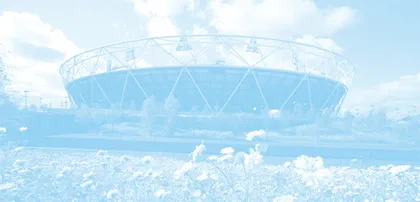Ten Years On: Queen Elizabeth Olympic Park伊丽莎白女王奥运匹克公园十年
作者: 罗里·沃尔什 卢铭/译

Compared with the era of the dinosaurs or the life span1 of a giant sequoia, a decade isn’t a long time. Yet ten years ago can feel like ancient history. July 2022 marks ten years since London hosted the Olympic and Paralympic Games. From the ‘Isles of Wonder’ opening ceremony to Team GB’s record medal haul by the end, London 2012 captured the public imagination. Perhaps it still haunts us. Post-Brexit, Covid, Black Lives Matter and #MeToo, that ‘golden summer’ almost shimmers like a mirage from another age.
与漫长的恐龙时代或参天红杉的寿命相比,十年只算得上是弹指一挥间。然而现在,谈及十年前,却让人感觉仿佛是在回溯古代历史。2022年7月是伦敦主办奥运会和残奥会十周年。从“奇迹之岛”的开幕式,到最后英国队创纪录的奖牌总数,2012年伦敦奥运会引发了公众的无限遐想。也许,时至今日它仍萦绕于我们心头。英国脱欧、新冠疫情暴发、黑人人权运动“黑人的命也是命”和反性骚扰运动“我也是”相继发起——经历这一切之后,那个“金色夏天”微光闪烁,仿佛是另一个时代的海市蜃楼。
‘The Games gave us a sense of pride and we’re not good at being proud of ourselves in Britain,’ says Dr Helen Rawling, this trail’s creator. Rawling’s trail loops around the southern end of what is now the Queen Elizabeth Olympic Park in Stratford. The route explores the park’s ongoing development and wider questions around regeneration. Rawling wrote it as a cultural geographer and a local resident. ‘I moved to this area in 2006 so I’ve seen how much the site has changed, before and after the Games.’
公园散步道的创建者海伦·罗林博士说:“奥运会给我们带来了自豪感,在英国,我们并不容易找到这种感觉。”伊丽莎白女王奥林匹克公园坐落于斯特拉特福德,而罗林的步道如今就环绕着公园的南端。这条路线旨在探索公园当下的发展及更广泛的生态重建问题。罗林以文化地理学者和当地居民的双重身份撰文介绍过它:“我在2006年就搬到了这个地区,所以我目睹了这个地方在奥运会前后所发生的变化。”
We are sitting on a bench in a plaza outside a department store. Westfield Stratford City is one of the largest shopping centres in the UK. Either side of us are rows of tall, glass-fronted shops. Footsteps echo on polished floors, muzak2 wafts through the air. It seems an incongruous place to start but Rawling explains: ‘During the Games around 180,000 people came to the Olympic Park every day. About 70 per cent of them were funnelled3 this way, through Westfield.’
我们坐在一家百货公司外面广场的长椅上。西田斯特拉特福德城是英国最大的购物中心之一。我们两边都是一排排高大的玻璃幕墙商店。锃光瓦亮的地板上回响着脚步声,空气中飘荡着各式背景音乐。步道由这里起步似乎并不合适,但罗林解释说:“奥运会期间,每天有大约18万人来到奥林匹克公园。其中约有70%的人是经由西田这条路汇聚而来。”
Arching towards us is a huge footbridge. Tinted glass walls, at least 12 feet high, flank4 it like giant insect wings. ‘Signs at Stratford railway station lead people onto that bridge, away from the old Stratford Centre,’ says Rawling. When new visitors arrived for the Olympics, older areas were left behind. With Westfield on their doorstep, Rawling suspects many locals rarely visit the West End. Like Canary Wharf in preceding decades, the Olympics have shifted the capital further east.
我们面前是一座弓形的巨型天桥。天桥两侧至少12英尺高的有色玻璃幕墙犹如巨大的昆虫翅膀。“斯特拉特福德火车站的指示牌引导人们走上这座桥,远离老斯特福德中心。”罗林说道。新游客为奥运而来时,老城区隐入幕后。由于西田就在家门口,罗林怀疑大部分当地人都不太去西区了。就像前几十年金丝雀码头的发展一样,奥运会已经将首都进一步向东转移了。
After passing through Westfield, the trail enters the Olympic Park itself. The official website describes it as ‘a world-leading destination for sport, entertainment, culture, education and relaxation’. On this warm May morning, with an azure blue sky, landmark venues span the scene in a panoramic5 postcard. The former Olympic Stadium (now the London Stadium, home ground of West Ham United), is straight ahead along an axial view. To the left, the red scribble of the Orbit Tower overlooks the distinctive London Aquatics Centre. To the right is a surprise: a large building site. While a flock of construction cranes loom above, the air echoes with the clangs6 and wails7 of power tools. Regeneration is a long-term process.
穿过西田商业区,步道直入奥林匹克公园。官方网站将其描述为“一个世界领先的体育、娱乐、文化、教育和休闲之地”。在这个温暖的5月清晨,湛蓝天空下,地标性场馆横跨眼前,犹如一张全景明信片。沿中轴线一直向前,就是前奥林匹克体育场(现在的伦敦体育场,西汉姆联队主场)。左侧,通体锈红狂野的轨道塔俯瞰着别具一格的伦敦水上运动中心。右边,则让人料想不及:是一个大型建筑工地。大批建筑起重机在上方忽隐忽现,到处回荡着电动器械的当啷声和呼啸声。重建需要不短的时间。
Outside the London Stadium, a couple of pre-schoolers frolic in the fountains. ‘This place will be packed tomorrow,’ Rawling comments. It’s a Friday. Football? ‘No, just people bringing their kids for a day out.’ Rawling and her young family live in Bow, a 20-minute cycle ride away. ‘We visit regularly; it’s safe, clean, great for families. The park was a vital open space during lockdown.’
伦敦体育场外,几个学龄前儿童在喷泉中嬉戏。“这个地方明天将会挤满人。”罗林评论道。今天是星期五。明天有足球赛?“不是,人们就是带着孩子来玩上一天。”罗林的孩子还小,一家人住在鲍区,骑车20分钟就能到这里。“我们经常来。这里安全、干净,很适合家庭游玩。疫情封控期间,这个公园是一个重要的开放空间。”
Humans aren’t the only beneficiaries. A zigzag path through young trees leads down to the City Mill River. Rawling often spots cormorants here, drying their wings in the sun. Pitting the concrete bank are a series of notches and holes. We glimpse sand martins popping in and out. The holes are industrial remnants. The City Mill River is one of various waterways that braid the Olympic Park. Many are tributaries8 and man-made diversions of the River Lea. By the 19th century, they were harnessed9 to make silk, dyes, porcelain, plastics, chemicals and matches. When these industries declined, the polluted waterways were abandoned. ‘One of the park’s big successes was restoring and opening them up,’ says Rawling. ‘They are also incorporated into the park really well, which helps increase biodiversity.’ The rejuvenated River Lea supports 300,000 wetland plants, which in turn encourages wildlife. The London Legacy Development Corporation (LLDC) records that the park’s residents include 13,000 trees, 60 bird species and 250 types of insects.